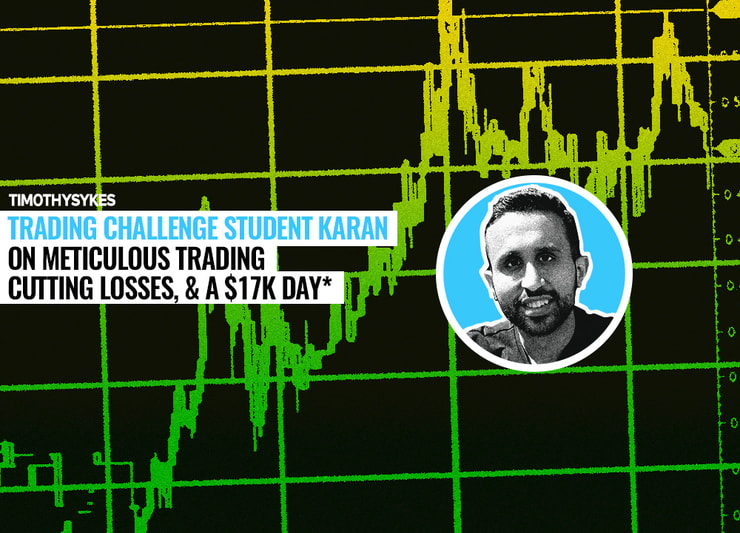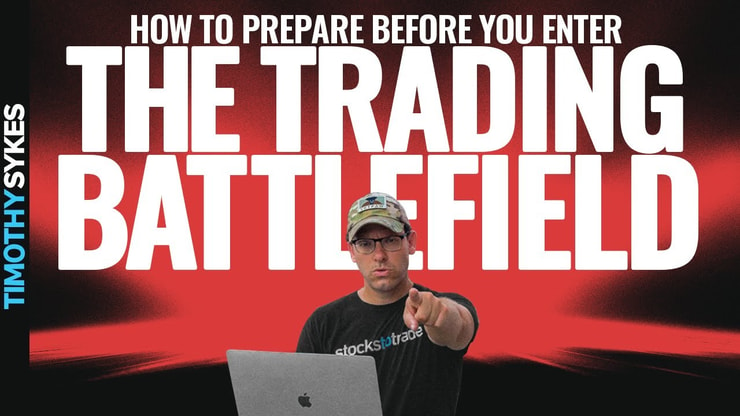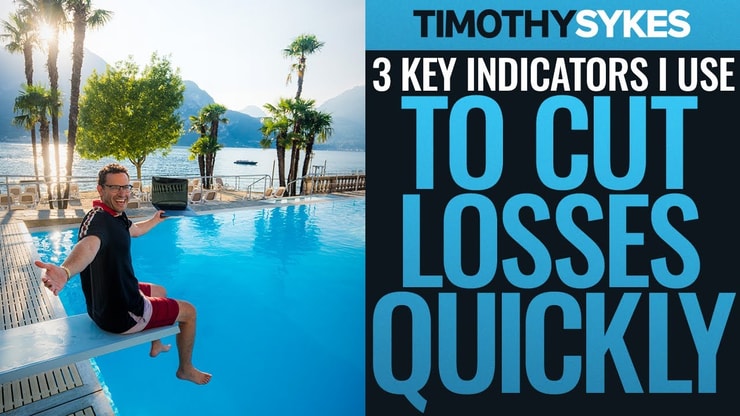My Trading Challenge student Karan makes trading look so easy.
He started 2020 with a $2,500 account — now, he’s over $50K in profits.*
It’s a common thread with high-achieving traders — they make trading look effortless. This can attract newbies with a ‘get rich quick’ mindset … but looks can be deceiving.
Too many newbies don’t realize that long-term trading success and consistency is the result of a lot of hard work.
Take Tim Grittani, for example. He started with $1,500. Now, years later, he’s up over $12 million.* That didn’t happen overnight. He didn’t start trading right away. His first nine months, he made nothing.
Or how about my student Roland Wolf? He recently joined the seven-figure club after starting with $4K.* He makes it look easy, but it’s been years of grueling work…
My top students are smart, skilled traders. They all have different strategies … and a lot in common. They’re meticulous, track their trading data, and continue to learn every single day…
I’m proud of Karan’s trading this year. But I’m even more proud of his work ethic. He started out in my Trading Challenge in 2017. And he focused on building a solid knowledge base before he started trading.
Karan prepared and had the right mindset. Things happened fast for him this year. But don’t forget all the behind-the-scenes work.
Let’s look at Karan’s career so far…
(*These results are not typical. Individual results will vary. Most traders lose money. My top students have the benefit of many years of hard work and dedication. Trading is inherently risky. Always do your due diligence and never risk more than you can afford to lose.)
Table of Contents
Karan’s Trading Story

When Karan started trading, he didn’t know what he was doing. He admits, “I didn’t even know what a broker was. I was that bad!”
It all started in 2017, during his fourth year at university. He’d just launched a tech startup. It ended up failing, but his entrepreneurial spirit wouldn’t quit.
He started looking for a new skill to keep him occupied. That’s when he stumbled upon the Trading Challenge.
He read my story and Tim Grittani’s story and got interested: “I wanted to give it a shot. Within a week of discovery, I signed up for the Trading Challenge. I thought if it was a scam I could expose it; if not, I could make some money.”
Sound familiar? I’ve had plenty of students who started out skeptical. My Trading Challenge student Stephen Johnson started out with a very similar logic — now he’s up over $40K in profits.*
Karan joined the Challenge in 2017.
In 2018, he spent the entire year learning. Then in 2019, he took a hiatus for personal reasons.
Finally in 2020, he was ready to roll. He was watching my other students getting ahead. He saw what they’d done, and he wanted to do it, too.
How Much Does Karan Study?
In his early days in the Challenge, Karan focused on filling his knowledge account. He’d devote as much as 12–14 hours per day watching the markets and studying.
“I had the luxury of a work-from-home job, so I would just sit in front of the markets and see the charts … In the evenings, I’d record all the charts and try to find an edge that fits my personality.”
These days, his study schedule is a little more relaxed, but learning is still a priority. “I still put in time on weekends to study and come up with new setups or optimize my current setups/risk management and watch videos when I have time.”
Karan’s Experience in the Trading Challenge
The Trading Challenge was a huge educational resource for Karan on his trading journey. He hit up my DVD lessons as well as my students’ lessons (“Trading Tickers” is a favorite.)
But the chat room, in particular, proved pivotal for him:
“The Trading Challenge chat room is like no other chat room … How open everyone is to sharing their knowledge and helping other traders is truly amazing. In my opinion, if traders join the chat rooms and learn from the alerts of Tim Grittani, Mark Croock, Kyle Williams, and Jack Kellogg, their knowledge curve will be accelerated tenfold.”
But take note: he said learn from their alerts — don’t just be a follower!
Karan’s Tips: Getting The Most From the Trading Challenge
Are you thinking about applying for the Trading Challenge? Here are Karan’s tips for potential students:
- It’s not just a matter of win or lose. Recognize that most traders will make most of their money from just about 10% of their trades. It’s all about small wins over time!
- Study smarter. A lot of traders spend time studying which setups to trade, but there’s also a learning curve on setups to avoid. This is something he’s actively working on.
- Screen time is a must. Without screen time, it’s hard to keep emotions in check.
- Make sure your risk level is appropriate for your account size. According to Karan, the “worst thing for any trader is to be out of the game when the market is tough and then have no money left to trade the easy setups when the market becomes hot.”
How Karan Trades Now
Karan is a great example of how I want all of my students to be: self-sufficient.
He took the time to learn the patterns I teach … and then he adapted my techniques and developed specific setups of his own.
As a trader, he likes to be adaptable. As he puts it, “I would like to think I don’t have any bias in terms of my trading. I go long and short.” It all depends on the market and the setup.
More Breaking News
- LSB’s Remarkable Stock Surge: Should You Buy?
- Decoding CIFR Stock’s Remarkable Surge
- Reddit’s Recent Roller Coaster: What’s Next?
Karan on Key Setups
There are the key setups Karan looks for:
- Multi-day breakouts on high volume: Karan only buys these kinds of setups in the afternoon. For him, the stock “needs to prove that buyers are interested and there’s significant volume accumulation.”
- First green day, high volume: Again, Karan looks to buy in the afternoon — “after the stock has shown strong consolidation all day and is breaking out to new intraday highs.”
- Dip buy into major panic: With this setup, Karan will “buy in the morning as the volatility is high and after the stock has panicked 20%–30% from the previous day’s close, when the odds really stack up for a good 20%–30% bounce (the stock has to be a multi-day runner for me to dip buy.)”
- Overextended gap down: This isn’t Karan’s favorite setup in the current market, but notes that “if I see the stock has more than 50–60 million in volume trapped the day before and the gap down is not more than 10%, I look to trade this setup.”
- Shorting green-to-red moves: This is one of Karan’s favorite setups. As he puts it, “When the stock runs for multiple days and keeps gapping up each day, the odds keep favoring shorts. When the stock goes green to red, that’s the first sign of a momentum shift — shorts have a reason to go aggressive and buyers have a reason to sell. Also, this setup has a lot of range and can be swung, in my opinion.”
- Shorting into resistance: Another one of Karan’s favorite setups: “After the stock has run for some days and is back near its lows, and after a week or so the stock gaps up on news, it’s a good setup to short into some spike. Bagholders who were trapped from the previous run would look to sell and shorts will look to attack.”
Karan’s $17K+ Profit Trading Day

2025 Millionaire Media, LLCMidway through 2020, Karan really started to find his trading stride.
He says his ‘aha’ moment came “once I understood the buyer/seller psychology and also got to see a lot of trades working this year in action that followed the framework … Also, I discovered how to size into a trade while keeping risk small and still accumulate a decent size position.”
As of late June, he’d built his $2,500 account to about $11K.* That’s already an incredible achievement. But on June 30, he had his biggest day of trading — ever.
How It Happened
Before I get into the trades that made him $17K+ in a single day, a word of caution.*
On this trading day, Karan used leverage — a lot of it.
I hate leverage. And I never suggest traders use it, especially new traders.
But I respect that Karan had a plan.
Note: Need help planning your trades? Start by signing up for my FREE weekly watchlist.
He’d been preparing to trade CytoDyn Inc (OTCQB: CYDY) for days. He knew the stock was heavily traded. And he knew that he wanted to attack the front side because it would be hard to fill.
He doesn’t usually use leverage … but he did this time.
“I was leveraged 50% with a $30K leverage on that trade … It was planned. Everything was planned. It was basically, ‘I’m gonna short x amount of size on the front side and I’m going to short x amount of size on the green-to-red move.’”
He was cautious, taking paper cuts — smaller losses — while he tested his trade thesis. As he says, “I took about $2K worth of paper cuts. The stock trapped me … and a lot of people in the chat room.”
Even with a high amount of leverage, he was being smart about his risk — he only risked about $200 to $300 on any given trade.
His two biggest trades on CYDY were for $13,467* and $3,130, respectively, with a few other wins in the mix.* These wins far outweigh the combined losses of about $2K that day, for a total of over $17K in profits.*
In a day, his account more than doubled — he went from about $11K to just under $30K.*
Learning to Cut Losses
Every trader hopes for a home-run play like Karan had with CYDY.*
It’s awesome when they come along … But you can’t count on them or expect them. All you can do is be prepared.
You heard a key part of Karan’s big win was that he took paper cuts along the way. He cut losses and only stayed in the trade when he knew it was his play.
Karan says, “The thing about trading is that you can be wrong 50% of the time and still be profitable. It’s crucial to manage your position sizing. In my opinion, it’s even more important than winning.”
He continues, “I only win 40% of the time, but I manage my positions so well that when I hit a winner, that winner will probably take the previous 10–15 losses off of my account. I’m at the point where I’m taking in big gains with big size. But if I’m losing, I’m only losing $100 to $200 on average.”*
Karan’s Biggest $8.3K Loss
Karan’s totally transparent about his trading — the good and the bad.
On August 3, he had a massive loss of $8,334 on Grayscale Digital Large Ord. (OTCQX: GDLC). Ouch.
No matter how long you’ve been trading, a loss like this hurts. Trust me, I’ve had big ones — like my biggest loss of $500K. I talk about that loss in my autobiography, “An American Hedge Fund.”
But you can always learn from losses, and Karan has some key lessons from GDLC.
For one, things can go wrong even if you have a solid plan.
The trade conditions were good. The setup was there. It was a third green day. The stock was already overextended, and he had a solid trading plan to go short.
He sized in small when the spread was 10–15 cents. When he saw a parabolic move, he added to his position — but then the stock started going higher.
Within a matter of minutes, the stock went from $17 to $20 … $25 … $30 … $35. The stock was illiquid. At this point, the spread was so high, he had no way to cover.
As he put it, “the only thing I could do was manage my emotions, recognize that I have seen this pattern a number of times, and cover on a pullback.”
If the stock had been more liquid, he might have gotten out easier — “I would have been out for a $300, $400, worst case $1,000 loss, and I would have tried again and maybe come back profitable on the trade.”
Karan Is Learning From His Mistakes
In retrospect, Karan says he was lucky. Most of his account was intact, and he knew what he’d done wrong.
Now, he’s updated his stock scans so he doesn’t see stocks that aren’t trading with sufficient volume. They don’t even pop up on his radar anymore.
Karan wrote an awesome post about his biggest loss of the year — check it out here. It’s honest. Reading it could help you avoid this kind of loss!
Karan’s Biggest Challenges and Goals Now
What’s on Karan’s mind moving forward? Improving and growing.
His Challenges
He says, “I have a lot to learn. I’m still very much a novice trader.”
One thing he’s trying to overcome? Revenge trading, trying to make up for losses. He noticed that revenge trading usually only leads to a slew of paper cuts that put him in a bad mood and chip away at his account.
“I really had to force myself to work on it, and I think I’ve gotten it under control. Now, once I have a loss, I can walk away.”
His Goals
Right now, Karan’s primary goal is to pass $100K in profits. But that’s not all he wants to achieve.
“The second thing on my immediate list is to really zone in on finding an edge on the day one gap and craps. They have a massive amount of range when they fail. So when the stock is gapping up, I want to time my entries.
Because of the range, you don’t need to put in a lot of money to make a lot on a good setup. But you need a good edge because if you get squeezed you’ll end up losing a lot. You’ve gotta really know your stats, so I’m trying to learn how to scale into a trade like that.”
Right now, he’s analyzing scaling in, timing, and how high a squeeze might run to assess his best entry.
Parting Words from Karan: Advice for New Traders
Gather Data
Karan notes, “One thing I was really bad at when I was starting out was figuring out the best support and resistance levels. Knowing support and resistance is super important!”
You Don’t Need to Trade Every Day
A lot of people want to trade every day. Karan was like that too. “What happens is there’s a shady setup you’re taking. You’re losing money on it, down $100, $200 on that trade…”
But more importantly, Karan says, “you’ve now drained your mental capital. So now, the next time a great trade comes along, you’re already so drained mentally that you’ll be too scared to attack that trade and risk. Because you gave away your profits, you might have been settling for D+ setups. When an A+ trade comes, you’re not prepared.”
Have Strict Criteria
Karan says, “I’m not looking for every and any runner. I’m looking for very strict criteria. The more strict your criteria, the less you’ll trade. That gives you more size to attack with.”
Remember to be patient & let the best trading setups come to you, you do NOT have to trade every minute, hour or even every day/week. Patience is difficult so that's why most traders don't practice it/that's also why most traders lose on non-ideal setups that lead to frustration!
— Timothy Sykes (@timothysykes) September 16, 2020
Avoid Low Float Stocks
Karan cautions that “anyone who’s trying to trade the short side and new should definitely avoid low float stocks. I think that they’re the most dangerous stocks. I don’t even touch them until they’re overextended. If a stock has a low float, you can’t quickly cover it. The slippage is high, so you can’t take a massive size to make a massive gain without worrying about that slippage.”
Focus on Easy Setups
For new traders, Karan suggests focusing on the easiest setups. “Wait for it, take a big size, wait for the easy setups. Stats say there are at least six, seven, or eight great setups per month. Concentrate on those.”
Want to trade beside dedicated, committed traders like Karan, Grittani, Roland and so many others? Apply to the Trading Challenge. But only if you’re ready to do the work.
What do you think? Are you willing to study and continue to learn every day? Leave a comment and let me know your favorite lesson from Karan!














Leave a reply